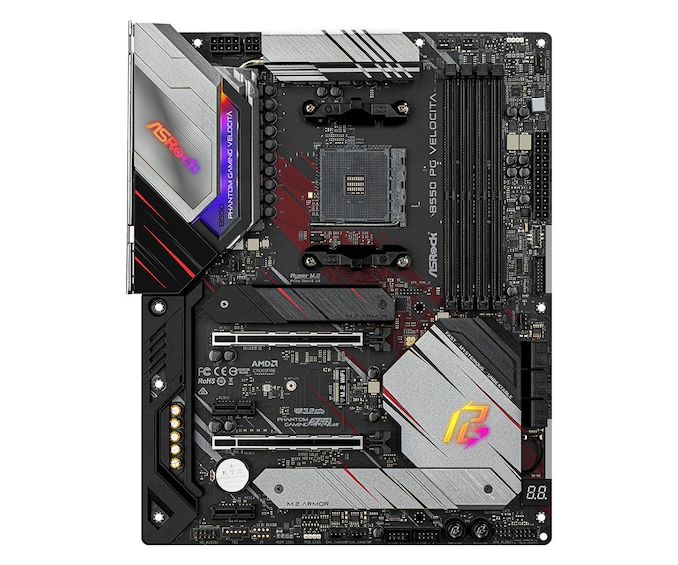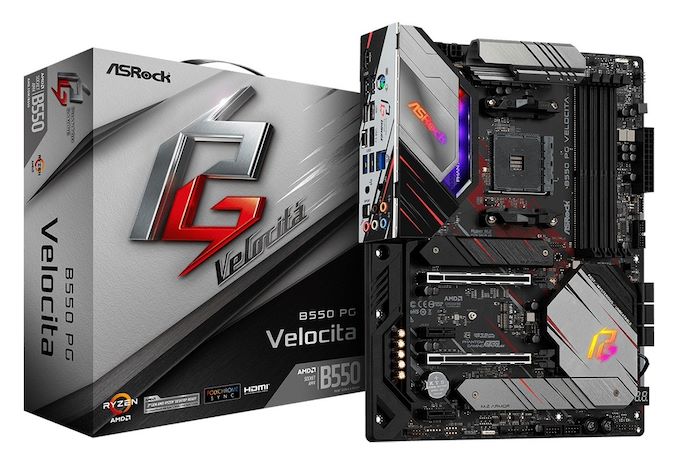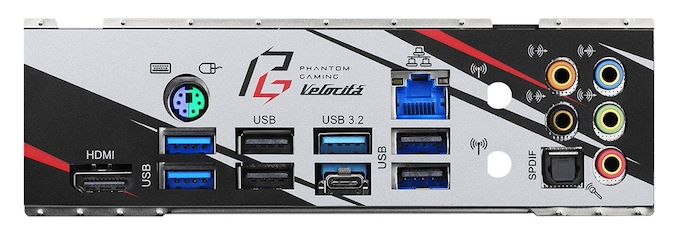The AMD B550 Motherboard Overview: ASUS, GIGABYTE, MSI, ASRock, and Others
by Dr. Ian Cutress & Gavin Bonshor on June 16, 2020 11:00 AM ESTASRock B550 PG Velocitá
The new Velocitá branding from ASRock, as started on Z490, is an attempt to define a high-end motherboard based on speed, but also style, hence the name ‘Velocitá’. In previous incarnations, ASRock motherboards would often show pictures of high performance sports cars that eerily looked very close to the popular Lamborghini of the day, but those boards were focused on overclocking. This time Velocitá is more about the gaming, hence it falls under the Phantom Gaming family.
The PG Velocitá is a relatively clean board to look at, with the main style focused on a 45-degree downward slope from left to right, and a number of jagged edges on decals around the motherboard. As we can see, there is also some element of RGB here, on the chipset heatsink and on top of the rear panel. There is also a pair of onboard RGB headers at different ends of the board.
The power delivery heatsinks in the Velocitá are connected via a heatpipe, hiding a 12+2 phase design indicative of which market ASRock wants to push this product. Powering the CPU is an 8-pin and a 4-pin, while the socket area has access to five 4-pin fan headers within easy reach.
Down the right side of the motherboard is a Type-C front header, a USB 3.0 front header, six SATA ports from the chipset, and a two digit debug. Along the bottom are more fan headers, two USB 2.0 headers, power/reset buttons, and a front panel connector.
For the PCIe layout, the top full-length slot is a PCIe 4.0 x16 slot from the CPU, while the second full-length slot is a PCIe 3.0 x4 from the chipset. Surprisingly both of these have additional reinforcement. There is also a PCIe 4.0 x4 M.2 slot above the top PCIe slot for the main M.2 drive, and ASRock puts another PCIe 3.0 x2 M.2 slot on the bottom of the motherboard, and this heatsink is connected to the chipset heatsink.
The audio on the right of the motherboard is an enhanced Realtek ALC1220 design, featuring an NE5532 amp.
The rear panel gives the user a HDMI port, a combination PS/2 port, two USB 3.2 Gen 1 ports, four USB 2.0 ports, a Type-A USB 3.2 Gen 2 port, a Type-C USB 3.2 Gen 2 port, a Realtek RTL8125BG 2.5 gigabit Ethernet port, space for an add-in Wi-Fi antenna output, and the audio jacks.













101 Comments
View All Comments
Savikid - Tuesday, August 25, 2020 - link
But the new oculus stuff only uses 1 usb port, so that right there is a drop. I use 2 for keyboard and mouse, one for a wireless controller, and one for my HMD.Gigaplex - Tuesday, June 16, 2020 - link
"On that one I added a USB PCI card to get enough ports."That's not really helpful to the user who said they can't add in a card on their mITX system.
eye4bear - Wednesday, July 1, 2020 - link
Must be nice to have no external hard-drives, I have 3 all needing their own USB 3 port, along with a Logitech dongle that runs both my mouse and keyboard, finally a Bluethooth dongle as my computer has none built-in. Yes I would need 6 USB ports (one open for USB sticks) just to keep even.consolessuck - Friday, November 6, 2020 - link
No, I have 3 usb ports on my laptop and i only use 1 for my mouse. As it turns out, the most amount of usb ports i use at once is two when i am making a wired data transfer with my mouse plugged in. Actually, I almost never transfer data to my phone with a wire, instead just sharing them via bluetooth. and considering i never make large data transfers to my phone, this works out just fine. as for a desktop, however, i'd like a minimum of 3 as i'll always have not only a mouse, but a keyboard plugged in all the time.taz-nz - Thursday, June 18, 2020 - link
The Asrock B550M Steel Legend has 8 port on the back:4x USB-A 3.1 ports
1x USB-A 3.2 port
1x USB-C 3.2 port
2x USB-A 2.0 ports
And you still have two USB 2.0 internal header, plus two USB 3.1 internal headers.
So that allows you to have another
4x USB-A 3.1
4x USB-A 2.0 ports.
so that's 16 Ports
Now if you like me and need Internal USB 3.2 USB-C header, you can use the PCIe 3.0 x2 m.2 slot to add one of these:
https://www.delock.de/produkte/S_63998/merkmale.ht...
or if you want two more USB 3.1 internal header you could add one of these:
https://www.delock.de/produkte/G_62843/merkmale.ht...
So if you can live without a second m.2 slot you have four more USB-A 3.0 ports.
That gives you 20 USB ports without giving up a PCIe slot.
taz-nz - Thursday, June 18, 2020 - link
oops, just noticed you said mITX not mATXdesii - Tuesday, June 16, 2020 - link
Do any of these motherboards support ECC RAM (either buffered or unbuffered)?drSeehas - Wednesday, June 17, 2020 - link
Socket AM4 CPUs support only unbuffered RAM.PixyMisa - Wednesday, June 17, 2020 - link
I did a quick look on ASRock's site, since they're pretty good on ECC support, and every B550 board I checked lists ECC as supported.Samus - Tuesday, June 16, 2020 - link
I think AMD screwed up here with pricing their platforms appropriately. I understand the push for PCIe 4 but they can't have average motherboard prices hovering between $200-$300. There has to be $100 motherboards to be taken seriously especially by OEM's if they want 4000 parts to become mainstream.But maybe they don't...maybe they plan to milk the 3000 parts for a few years. After all, there isn't much reason not too. They have no competition from Intel in the budget segment right now.